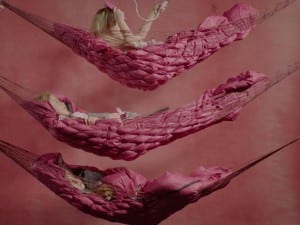Text by Emma Cummins
Notorious for his controversial and ethically dubious video-works, Santiago Sierra is a contentious and well-known figure in the field of contemporary art. Both politically and aesthetically provocative, his work combines elements of social and institutional critique to confront the problems of labour and the politics of contemporary culture. Best known for works such as 160 CM LINE TATTOOED ON 4 PEOPLE (2000), or 68 PEOPLE PAID TO BLOCK A MUSEUM ENTRACE (2000); Sierra exploits the terrible inequalities of society to proffer perspicacious insights into the history of art and the realities of neoliberal capitalism.
A magnet for writers and critical theorists, Sierra could be construed as a facilitator – an artist whose wilful exploitation of people results in live, participatory events that are documented and displayed as “art”. As highlighted in Dedicated to the Workers and Unemployed, a mid-career retrospective at London’s Lisson Gallery, the camera is key to this process; a silent, yet indispensable witness to his uniquely prescribed artistic contexts.
At the Lisson, visitors are greeted with a room of 14 wall-mounted monitors and headsets. Revealing a selection of the artist’s well-known video works, the room is a cleverly curated montage of Sierra’s participatory works from the late 1990s to 2011. From 100 HIDDEN INDIVIDUALS (2003) to THE WALL OF A GALLERY PULLED OUT, INCLINED 60 DEGREES FROM THE GROUND AND SUSTAINED BY 5 PEOPLE (2000); we see grainy, black and white shots of people engaging in durational performances that toy with notions of power, surveillance and social complicity.
Realised in a variety of different locations – in galleries, streets, office blocks or abandoned buildings – works such as 8 PEOPLE PAID TO REMAIN INSIDE CARDBOARD BOXES (1999) are loaded with paradox. Both social and sculptural; culturally rich yet morally ambiguous, their oxymoronic allure is compelling and disturbing in equal measure. In this particular work, we discover (through the video’s disconcertingly self explanatory title) that a collection of cardboard boxes are components in a unique, participatory performance. Paradigmatic of Sierra’s documentary video-work, the piece nods towards Minimalist sculpture and the history of Conceptual Art, yet seethes with the uncomfortable presence of people who quietly comply with the artist’s instruction.
Whilst Sierra, in the wake Claire Bishop’s essay Antagonism and Relational Aesthetics (2004), has long been associated with the field of relational aesthetics; contemplation of this particular work reveals that Sierra’s ostensibly “relational” works could be read as ruminations on the unnerving, invisibility of power. Subsequently, his inhabited cardboard boxes – breathless, yet quivering with life – could be interpreted as a visualisation of power relations, their disquieting ambiguity and concrete social effects.
If, as the great theorist and philosopher Henri Lefebvre once said, space is a “social product”, not an empty container of social relations; Sierra’s work seems to proffer an image of the intangibility of capitalism and its ideological hold on the body. Unlike relational aesthetics however, where the artistic medium is the body – or the interaction between bodies through human relations – Sierra’s work contains a sculptural aspect that is often critically overlooked. It is significant then, that whilst the majority of works at the Lisson are materialised as videos, the last room of Dedicated to the Workers and Unemployed contains a new and revelatory sculptural work.
Loudly proclaiming the word “NO” in huge black lettering, it is a welcome aberration in a show that privileges documentation over empirical experience. Caught between two rare photographic works – where the word “NO” is projected above the Pope and across the chest of an unsuspecting policeman – the NO sculpture represents a new direction for Sierra, a full-blown embrace of materiality and potent, aesthetic presence.
Infused with an air of stubborn resistance, this loud and uncompromising sculpture is a facet of a large-scale video-work titled NO, Global Tour (2009-2011). Two hours in length, the film documents an unusual journey – a journey where two NO sculptures are transported on the back of flatbed trucks across Europe and the United States. In Berlin, Toronto, Rotterdam, Washington and many other places (most notably the industrial areas of cities) the sculptures – weighing half a ton each, and measuring about 5.10 by 13.12 feet – traverse everyday environments to create a kinetic sensation of hope and resistance.
Through the simple invocation of the word “NO”, a heavy irony forms a conclusion to this hard-hitting and expansive retrospective. If we consider the acts of complicity that make Sierra’s video work possible – the silent “yes” from his accepting participants – it seems apt to suggest that Sierra’s “NO” is a crude, yet productive indication of a significant, stylistic shift. If, as the artist routinely insists, his work merely represents the conditions of life that we are “uncomfortable confronting”; NO, Global Tour transmits a nebulous sense of possibility rarely seen in his earlier works.
Santiago Sierra: Dedicated to the Workers and Unemployed, 01/02/2012 – 03/03/2012, Lisson Gallery, 29 Bell Street, London. www.lissongallery.com
Santiago Sierra: Films and Works, 20/01/2012 – 10/04/2012, Reykjavík Art Museum, Iceland. www.artmuseum.is
Aesthetica in Print
If you only read Aesthetica online, you’re missing out. The February/March issue of Aesthetica is out now and offers a diverse range of features from an examination of the diversity and complexity of art produced during the tumultuous decade of the 1980s in Art, Love & Politics in the 1980s, opening 11 February at MCA Chiacgo, a photographic presentation of the Irish Museum of Modern Art‘s latest opening, Conversations: Photography from the Bank of America Collection. Plus, we recount the story of British design in relation to a comprehensive exhibition opening this spring at the V&A.
If you would like to buy this issue, you can search for your nearest stockist here. Better yet call +44 (0) 1904 629 137 or visit the website to subscribe to Aesthetica for a year and save 20% on the printed magazine.





